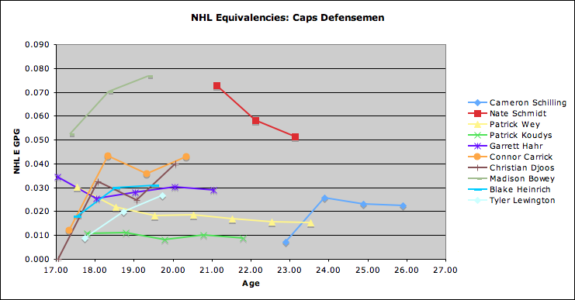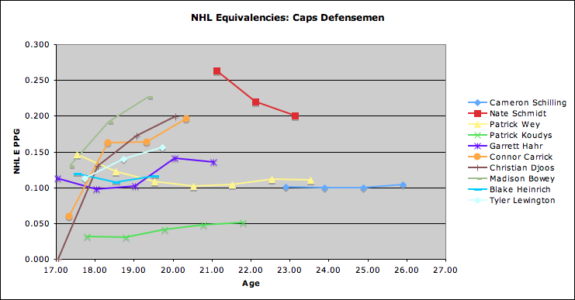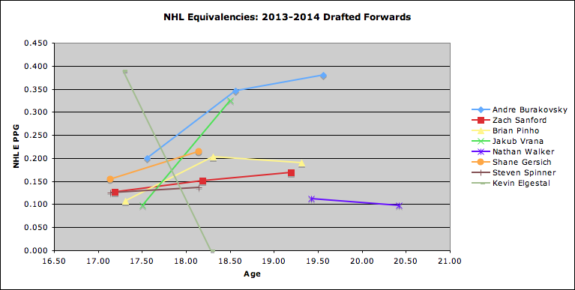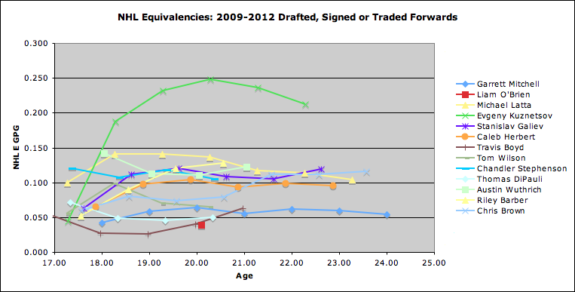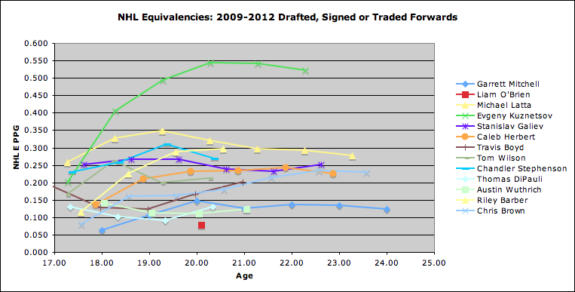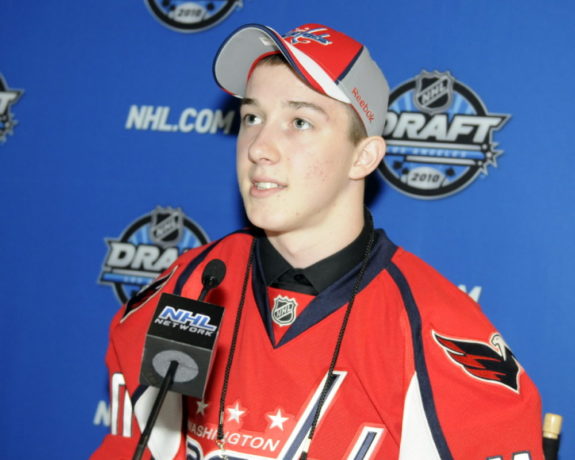
Last week, I showed you guys the basics of NHL equivalencies and how to properly analyze them. Now there are certainly flaws in just simply looking at a NHL Es and having that be the only way to project a hockey player coming out of the minors, juniors, NCAA or Europe. We still haven’t gotten a true grasp as to how a player is used for his respective team. We don’t fully know whether or not and how much a prospect is playing on special teams. Most importantly, these are RAW NHL equivalencies. Players can, all of a sudden, record 100 points at the AHL at age 30. Does that make him a top six forward prospect in the NHL? Heck, No! As I referenced last week, age-adjusting for every league is the next step to correctly analyze how well a future NHLer can perform.
So with that in mind, let’s take a look at how all the Capitals prospects are doing based on NHL equivalences. If you need a quick refresher as to how to calculate them and it’s cumulative average, you can find it here. All the prospects in this piece are skaters that were either signed or drafted from 2009 and have played less than 65 career NHL games coming into this season.
Defenseman
1) Nate Schmidt and Madison Bowey are clearly the belles of the ball and have proven enough that they should develop into puck moving, point-producing defenseman at the NHL level. Bowey’s prospects were already sky high after being one of Canada’s best defenseman at the World Junior Championships, but playing on a junior team with Josh Morrisey and Leon Drasaitl will also help in his production. For Schmidt, he is the ultimate example of someone immediately joining the pro ranks and seeing his growth stunted by sub-optimal deployments. I am not suggesting that Schmidt should receive top-line minutes in Washington, but you would have thought that the transition at the AHL and/or NHL would go smoothly for him.
2) One prospect that is benefiting at the AHL, however, is Connor Carrick. After being thrown into the fire by Adam Oates last year, the former sixth round pick has improved nicely while playing in Hershey by racking up seven goals and 32 points in 49 games. Now the question is how far can he develop as a defenseman and how many more years should he play with the Bears before he joins the Capitals again. Despite weighing only 160 pounds and still needing plenty of work on his overall game, Christian Djoos is another prospect that can’t be ignored. He has played for Sweden at the World Juniors and has already amassed over 130 career Swedish Hockey League games before turning 21.
3) One player that Caps fans might need to talk about more is 2013 7th round pick Tyler Lewington. While he may just end up meeting the minimum requirements of point production at the NHL level, Lewington has received positive accolades for the things he does outside the box score. If anything else, Lewington should be able to impress coaches that love fighting as he is flirting among the WHL leaders in that category.
4) Other than that, it will be a struggle for the remaining defensemen on the prospect list to make it to the NHL and/or develop into a puck-moving type. Cameron Schilling, Patrick Koudys and Patrick Wey are clearly shut-down players from the get go. However, players like Schilling and Haar are showing that they are starting to get too old to be able to make a name for himself and be able to stay on the Capitals roster for a long period of time. Blake Heinrich will need more data to be observed after he finishes his junior career and enters the professional ranks.
5) That being said, we are talking about as much as five defenseman that could last in the NHL. That’s not bad considering Washington seemed to be in dire straits when it came to signing, drafting and developing defenseman on-mass while the Capitals needed those guys in order to win a Stanley Cup between 2008 and 2010.
Next up are the forwards. Considering that so many were drafted or signed since 2009, there will be two sets of charts to look at.
2013-2014 Drafted Forwards
1) For all these guys, the sample size is not 100 percent there to make justifiable conclusions, but there is enough to see if certain players are taking positive or negative steps.
2) For example, Andre Burakovsky will be fine. There are definitely fears about his lack of playing time this season under Barry Trotz, but even after we discussed how 17-year old seasons in Europe can skew a players data too much, this chart should show that Burakovsky hasn’t been under-acheiving in 2015 either.
3) On the other hand, even if he is a seventh round pick, to see Kevin Elgestal only being able to play in two career Swedish professional league games is not a good sign for him.
4) Jakub Vrana is going to be an awesome goal scorer. If he can keep his production up by either playing in Europe for one more season or playing in the NHL next season while playing a full 82 games and 15 minutes a night, 20 goals should be an achievement he can pull off in his sleep for multiple seasons.
5) Sadly, Nathan Walker is either horribly overrated as a third round pick or he is another example of a player seeing his development decay miserably at the AHL level. It was fitting to see his season end to a knee injury at an ECHL game, a league much lower than he should be playing in.
6) As for the American prospects, it seems like none of them are projected to be top six forwards, but all of them could become solid third line types given the proper development. Brian Pinho is plateauing this season at Providence, but he should bounce back after finishing his freshman season with one of the best programs in the country. Zach Sanford is improving while playing for the most pressured college program in the country in Boston College. Next year, Shane Gersich will play for North Dakota while Steven Spinner will play for Nebraska-Omaha. Gersich has the potential of becoming another Riley Barber type with scouts raving about his speed and hard shot. Not bad for a fifth round pick.
Now let’s look at the remaining group of forwards that have much larger sample sizes.
2009-2012 Drafted Forwards
1) You can definitely see through this graph, it has not been a smooth transition from the KHL to the NHL for Evgeny Kuznetsov. Like Burakovsky, Kuzya has been a victim of not getting the playing time he deserves under Barry Trotz because of his distrust towards young players and his overreaction towards the big mistake. However, things are getting better for Kuznetsov as he has put up nine points in his last 10 games.
2) Did you know that Michael Latta used to be an underratedly good prospect. While we wait for Tom Wilson to be the next Milan Lucic, Latta was producing like that at the junior and AHL levels. His best season probably came in his age-18 season, where Latta recorded 33 goals and 73 points in 58 games with the OHL’s Guelph Storm. Then he was caught in Trotz’s doghouse, just like all the other under-23 forwards on this team.
3) Speaking of Tom Wilson, we need to put an end of him ever being considered a top-six forward. Simply put, it is a travesty that his NHL E has him worse than Chandler Stephenson, Caleb Herbert and Stanislav Galiev: three players that have gone through some really bad growing pains at the AHL level.
Until 2012, Wilson looked like someone that could develop into a solid, point producing forward. Then, the 2013-14 season happened and he was sent to the fourth line and become the team’s leader in fighting majors. This year, Wilson seams to be a man without a proper spot on the lineup and hasn’t been given any special teams role or a chance to develop his offensive touch. Even if the Capitals send Wilson to the minors because he is passed his OHL eligibility, they are doing so while in his second of a three-year entry level contract and it’s not a guarantee based on their track record that Hershey will be beneficial for him either. Even if he is still 21 years old, I am afraid we are hitting “put up or shut up” stage for Tom Wilson.
4) Another player that is gettng more production than Tom Wilson is Miami of Ohio standout Riley Barber. The captain of the United States at the 2014 World Juniors looks like he will finish his junior season averaging close to a point per game for the second time in his collegiate career, but questions will arise as to whether the Caps should sign him to a professional contract. Considering how Trotz has handled young players and how Hershey has not gotten the best out of their prospects, my money is on “no”, but you have to wonder what else is there for Barber to work on after performing so well for so long at the Collegiate level.
5) Travis Boyd and Chris Brown are two players that need to be paid attention to more often by Capitals fans this season. Boyd is finishing up his senior year at Minnesota where he is racking up 27 points in 21 games: third on the team behind Florida Panthers forward Kyle Rau and Columbus Blue Jackets defenseman Mike Reilly. For Brown, he is still two years removed from putting up 29 goals and 47 points in 67 games with the Portland Pirates. Since then, those points per game have declined, but it is still close to a point every two games clip. More research might need to be done for a player like Brown as to what the root of his disgusting puck possession and declining numbers have come from because he is not afraid to shoot the puck at the AHL level. In the last three years, Brown’s shots on goal per game has gone from 2.79, 3.06 (granted, it was only 2.16 per game in his 12 Hershey games in 2013-2014) and 2.90 shots per game.
6) Finally, it will be a long road for Thomas Di Pauli, Liam O’Brien, Austin Wuthrich and Garrett Mitchell to make it into the NHL. Di Pauli is not performing terribly at Notre Dame, but his 23 points in 31 games don’t translate well at the NHL level. Wuthrich isn’t doing better over in South Bend where he is struggling to maintain a half-point per game pace. O’Brien’s sample size needs to get better to make conclusions about his NHL future, but given his role at Hershey, it doesn’t seem like he’s developing a long-lasting NHL career so far. To see Mitchell only recording two points in 38 games is just not good enough to sustain any form of a professional career long term.
So in Washington, unless a forward is a former first round pick, it will be a struggle for him to score 20 goals or get to 40 points at any point in his NHL career. Riley Barber has a shot at being the one that could break that trend as a former sixth round pick, but other than him, it’s nothing but third and fourth line players on this side of the prospect pool.
This got me thinking about how director of Scouting Ross Mahoney, former General Manager George McPhee and current General Manager Brian McLellan have been using their second round picks over the years. If you have read my work from the beginning, you would have noticed my belief that only 35-40 skaters and 3-4 goaltenders end up playing five seasons worth of NHL games out of a typical NHL draft. In other words, your goal for every draft class is to be able to get more than one player that can be mainstays for your team. The best way to achieve that is by capitalizing on your first two rounds and/or hope that anyone outside of that can pleasantly surprise you.
For Washington, it has not been since 2006 when they invested their second round pick on a forward, and that player turned out to be Francois Bouchard. From 2010 to 2012, McPhee would go on to trade away those second round picks for mid-season rentals Eric Belanger, Joe Corvo and Jason Arnott, respectively. If those trades wouldn’t have happened, the Caps could have had the opportunity to draft someone like Nikita Kucherov, who was available where Washington would have picked in 2011 (that pick was 57th overall and was eventually passed on to Calgary where they drafted Tyler Wotherspoon). Second round picks are less likely to succeed and they are more likely to be traded away during the trade deadline, but these picks do find a way to be the difference between drafting well and meeting the bare minimum requirements.
